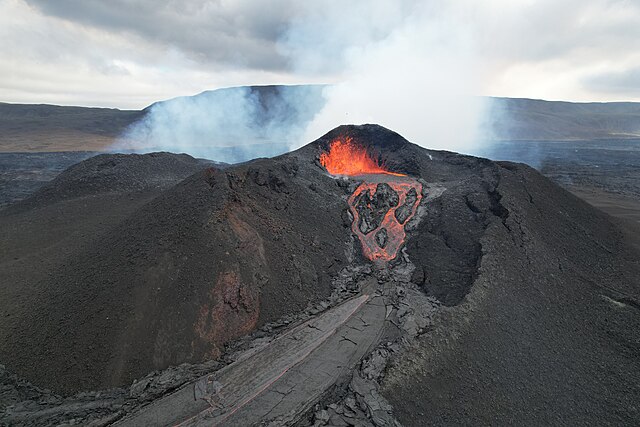
Title: Combatting Lava with Earth: How Basic Earthen Structures are Transforming Volcanic Disaster Preparedness
For the very first time, researchers have effectively shown that simple earthen structures—made from readily accessible soil and volcanic materials—can impede or redirect flowing lava from erupting volcanoes. This significant advancement in managing volcanic hazards has already shielded Icelandic communities from devastation, providing a feasible, scalable approach that could assist vulnerable populations worldwide.
The innovation, spearheaded by Professor Fjóla Guðrún Sigtryggsdóttir and her team during the 2021 eruption of the Fagradalsfjall volcano in Iceland, has the potential to alter how communities coexist with and protect against volcanic dangers. Through a potent mix of field tactics and thorough scientific research, this study has heralded a new phase of disaster preparedness characterized not by sophisticated containment technologies, but by the fundamental force of the earth itself.
A Natural Laboratory: The Fagradalsfjall Eruption
After being inactive for over 800 years, Fagradalsfjall erupted in March 2021, presenting both a stunning visual and an exceptional scientific opportunity. As streams of molten lava cascaded down the Reykjanes Peninsula, researchers initiated a daring experiment: Could rudimentary earthworks halt or redirect these fiery streams?
Utilizing excavators and bulldozers, the team constructed three dams and two diversion barriers using volcanic soil and gravel. These structures acted as shields between the lava and at-risk roads, residences, and essential infrastructure.
The outcomes surpassed expectations. The largest artificial dam managed to hold back the lava for more than two weeks, granting vital time for emergency preparations. The diversion barriers created to redirect the lava also proved successful in steering it away from safeguarded zones.
Understanding Lava Behavior: One Type Doesn’t Fit All
Lava comes in various forms, and the team’s research uncovered how distinct lava types react to physical interference.
Key differences included:
– ʻAʻā lava: This thick, slow-moving lava accumulates behind barriers, increasing pressure as molten rock builds beneath a solidified crust. Barriers must be tall and reinforced to withstand breaches or collapses.
– Pāhoehoe lava: This smooth, quickly flowing lava presents a different set of challenges. While it traverses around and over barriers more easily, its lesser destructive potential allows engineers time to make adjustments.
– Hybrid lava types: Display characteristics of both ʻā‘ā and pāhoehoe flows, necessitating adaptable barrier designs with varied shapes and reinforcements.
– Emergency berms: Temporary soil mounds provided teams the time needed to finish larger protective structures.
Strategic placement and the shape of barriers played a crucial role. Steeper inclines required sturdier constructions, while flatter areas benefitted from wider and lower barriers that safely diffused lava pressure.
Turning Research into Real-World Response
In the winter of 2023, the research underwent its ultimate evaluation. Volcanic activity threatened the coastal municipality of Grindavík and a geothermal power facility crucial to the region’s energy requirements. The Icelandic authorities acted promptly, employing the methods validated in 2021.
Within a month, enormous earthen barriers—some reaching heights of 10 meters and widths of 40 meters—were erected in key locations. When eruptions recommenced in December 2023 and again in January 2024, these defenses held firm. Although one lava fissure sliced through a protective wall, the overall success of the barriers in minimizing damage exceeded expectations.
For a town that could have faced total ruin, the contrast was notable. What might have necessitated months or years of recovery became a matter of days or weeks for repairs.
Why Earthen Barriers Work—and Matter
In contrast to costly, highly specialized mitigation systems, earthen structures provide three key benefits:
1. Speed of Deployment: Barriers can be rapidly built using bulldozers and diggers—often on the same day that lava threat levels rise.
2. Local Resources: Soil, rock, and gravel are usually abundantly available in volcanic areas.
3. Cost-Effectiveness: Rather than depending on high-tech solutions, this approach utilizes fundamental engineering and practical logistics.
Challenges and Limitations
Nonetheless, researchers warn that earthen barriers are not an all-encompassing solution. Under extreme contexts, such as steep slopes or very high-volume lava flows, these barriers might be overtopped, undermined, or even ruptured by lava pressure.
Moreover, high-heat conditions, toxic gases, and unpredictable fissures complicate construction during active volcanic threats, making it both perilous and challenging. Emergency preparation, protective gear, and real-time monitoring are essential for the successful implementation of barriers.
Toward a Volcanically Resilient Future
The Reykjanes Peninsula, home to 30,000 residents and about 8% of Iceland’s population, is now expected to remain volcanically active for the coming centuries. Since 2021, several new eruptions have reaffirmed the likelihood of prolonged geological unrest in the area.